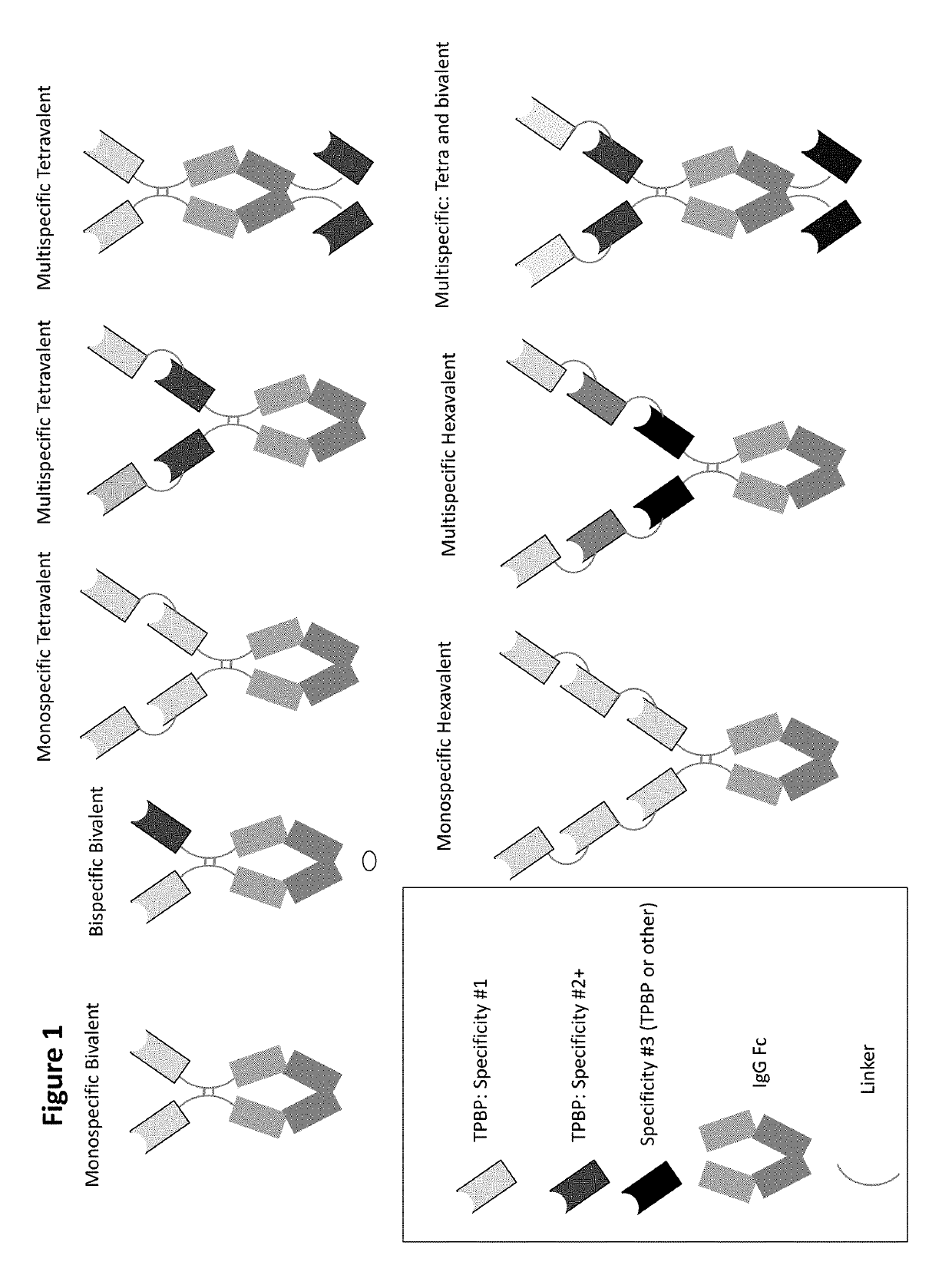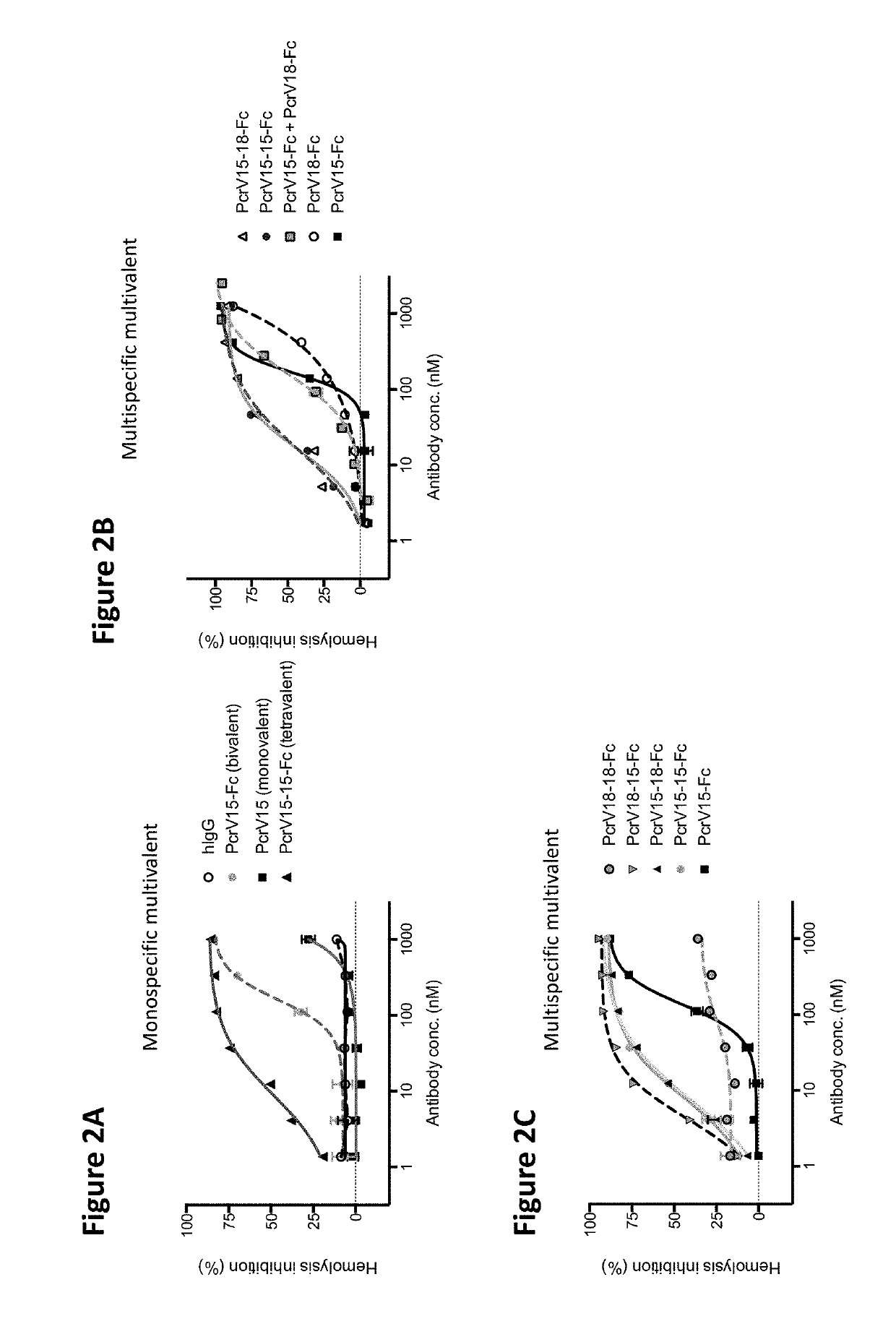Type III secretion system targeting molecules
a secretion system and molecule technology, applied in the direction of antibacterial agents, peptides/protein ingredients, peptides, etc., can solve the problems of cell death and lysis, serious and life-threatening infections of such bacteria, and achieve the effect of preventing ch3-ch3 dimerization and dimerization
- Summary
- Abstract
- Description
- Claims
- Application Information
AI Technical Summary
Benefits of technology
Problems solved by technology
Method used
Image
Examples
example 1
Blocking
[0117]The ability of the VPBPs of the present invention to block bacterial induced hemolysis of red blood cells (RBCs) can be assessed by numerous protocols known in the art. For example, human RBCs were washed in PBS and resuspended at 2% (v / v) in DMEM. Pseudomonas aeruginosa bacteria plus serially diluted antibodies were added to RBCs in 96 well round bottom plates. The plates were incubated for 2 h at 37° C. and then 2 h at 4° C. The plates were then spun to pellet intact RBCs, after which the supernatant was transferred to a flat bottom 96-well plate for spectrophotometric observation of released hemoglobin.
[0118]As shown in FIGS. 2A-2D, both monospecific and multispecific multivalent VPBPs of the present invention are able to block bacterial induced hemolysis of RBCs.
example 2
ity Blocking
[0119]The ability of the VPBPs of the present invention to block bacterial induced cytotoxicity of mammalian cells can be assessed by numerous protocols known in the art. For example, A confluent monolayer of A549 (lung epithelial) cells were grown in 96-well plates. Cells were loaded with Calcein AM and then washed to remove excess Calcein. P. aeruginosa and antibodies at varying concentrations were added to the A549 cells and incubated for 2 h at 37° C. Monolayers were then washed, after which the remaining cells were quantified by fluorescence.
[0120]As shown in FIGS. 3A-3B, both monospecific and multispecific multivalent VPBPs of the present invention are able to block bacterial induced cytotoxicity of mammalian cells.
Example 3: Pseudomonas aeruginosa Infection Model
[0121]The ability of the VPBPs of the present invention to protect against a bacterial infection can be assessed using a mouse model of P. aeruginosa infection. Mice were pre-treated with PcrV antibodies 2...
example 4
bodies Bind to Multiple Strains
[0122]The ability of OprI targeting antibodies to bind to Pseudomonas strains can be assessed by whole cell bacterial ELISA. Bacterial cultures were grown to mid-logarithmic phase in standard bacteriologic media, then washed and resuspended in PBS. Equal volumes of bacterial suspension were placed in 96 well plates and incubated at 37 C for 24 h. Plates were blocked with BSA and then serial dilutions of antibodies were added. After subsequent washing, HRP-conjugated anti-human Fc specific secondary antibody was added. Following incubation and washing, TMB substrate was added and absorbance at 600 nm was measured to detect binding of antibodies to bacteria. As shown in FIG. 5, OprI antibodies were found to bind to all strains of Pseudomonas aeruginosa tested, as well as Pseudomonas putida.
Example 5: Bispecific Molecules in Pseudomonas aeruginosa Infection Model
[0123]The studies presented herein demonstrate the ability of the VPBPs of the present invent...
PUM
| Property | Measurement | Unit |
|---|---|---|
| dissociation constant | aaaaa | aaaaa |
| size | aaaaa | aaaaa |
| molecular weight | aaaaa | aaaaa |
Abstract
Description
Claims
Application Information
 Login to View More
Login to View More - R&D
- Intellectual Property
- Life Sciences
- Materials
- Tech Scout
- Unparalleled Data Quality
- Higher Quality Content
- 60% Fewer Hallucinations
Browse by: Latest US Patents, China's latest patents, Technical Efficacy Thesaurus, Application Domain, Technology Topic, Popular Technical Reports.
© 2025 PatSnap. All rights reserved.Legal|Privacy policy|Modern Slavery Act Transparency Statement|Sitemap|About US| Contact US: help@patsnap.com



